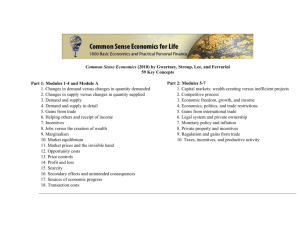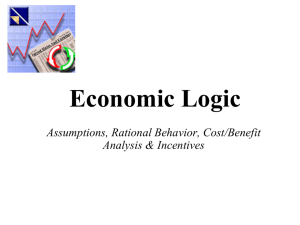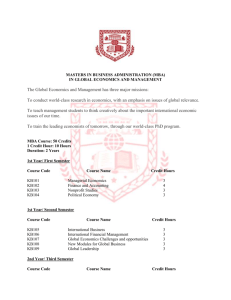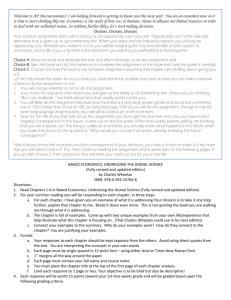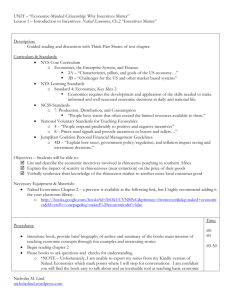lecture 1 - Vanderbilt Business School
advertisement
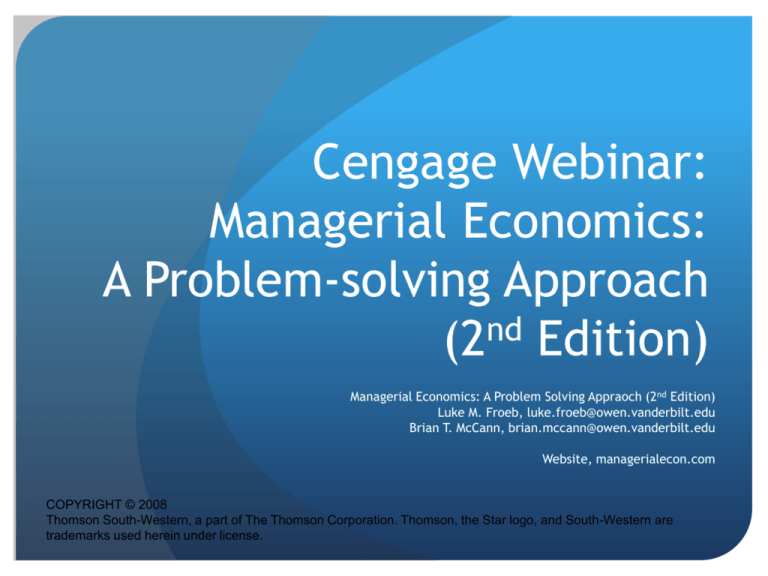
Cengage Webinar: Managerial Economics: A Problem-solving Approach nd (2 Edition) Managerial Economics: A Problem Solving Appraoch (2nd Edition) Luke M. Froeb, luke.froeb@owen.vanderbilt.edu Brian T. McCann, brian.mccann@owen.vanderbilt.edu Website, managerialecon.com COPYRIGHT © 2008 Thomson South-Western, a part of The Thomson Corporation. Thomson, the Star logo, and South-Western are trademarks used herein under license. Why is teaching economics to MBA’s so difficult? Students with varying backgrounds: English majors vs. Engineers; Econ. and Business majors; Executive MBA’s and non-degree Exec. Ed. Healthcare professionals Terminal class: Last microeconomics class most MBA’s will take Students want practical knowledge Not abstract theory Do MBA’s learn differently than we do? Solution Use a problem-based pedagogy (instead of model-based) Begin with a real business problem Give students just enough analytical structure to understand the problem and find a solution Teaches students to solve problems by Identifying profitable decisions (benefit-cost analysis) And implement them (principal-agent theory) Links study of economics to other MBA disciplines Accounting, finance, statistics, marketing, strategy, operations 4 Example: Over-bidding OCS gas tract • A young geologist was preparing a bid recommendation for an gas tract in the Gulf of Mexico. • With knowledge of the productivity of neighboring tracts also owned by company, the geologist recommended a bid of $5 million. • Senior management, though, bid $21 million - far over the next highest-bid of $750,000. • What, if anything, is wrong? • The goal of this text is to provide tools to help diagnose and solve problems like this. 5 Analyze the over-bidding mistake • Another clue: • After winning the bid, the geologist increased the estimated reserves of the company. • But, after a “dry” well was drilled, the reserve estimates were decreased. • Senior Management stepped in and rejected the decrease in the estimate (kept it high) • Last clue: • Senior management resigned several months later. ANSWER: Manager bonuses for increasing reserves • The bonus system created incentives to over-bid. • Senior managers were rewarded for acquiring reserves regardless of their profitability • Bonuses also created incentive to manipulate the reserve estimate. 6 7 Problem solving • Two distinct steps: • Figure out what’s wrong, i.e., why the bad decision was made • Figure out how to fix it • Both steps require a model of behavior • Why are people making mistakes? • What can we do to make them change? • Economists use the rational actor paradigm to model behavior. The rational actor paradigm states: • People act rationally, optimally, self-interestedly • i.e., they respond to incentives – to change behavior you must change incentives. 8 Keep the ultimate goal in mind Align the incentives of employees with the profitability goals of the company. • How do we make sure employees have the information necessary to make good decisions? • And the incentive to do so? 9 How to figure out what is wrong • Under the rational actor paradigm, mistakes are made for one of two reasons: • lack of information or • bad incentives. • To diagnose a problem, ask 3 questions: 1. Who is making bad decision? 2. Do they have enough info to make a good decision? 3. Do they have the incentive to do so? 10 How to fix it • The answers will suggest one or more solutions: 1. Let someone else make the decision, someone with better information or incentives. 2. Change the information flow. 3. Change incentives • Change performance evaluation metric • Change reward scheme • Use benefit-cost analysis to choose the best (most profitable?) solution 11 Coverage & Changes to 2nd ed. • Traditional coverage (see TOC) • Changes to second edition • Examples from the financial crisis • Additional material • Insights from behavioral econ (psychological pricing, barriers to rational decision making) • Iceland: Trade, Foreign Exchange, Bubbles • Chapters cut into smaller pieces • Uncertainty & Auctions • Long-run equilibrium & Strategy 12 1. Introduction: What this book is about Managerial Economics 2. The one lesson of business 3.Benefits, costs and decisions Table of contents 4. Extent (how much) decisions 5. Investment decisions: Look ahead and reason back 6. Simple pricing 7.Economies of scale and scope 8. Understanding markets and industry changes 9. Relationships between industries: The forces moving us towards long-run equilibrium 10. Strategy, the quest to slow profit erosion 11. Using supply and demand: Trade, bubbles, market making 12. More realistic and complex pricing 13. Direct price discrimination 14. Indirect price discrimination 15. Strategic games 16. Bargaining 17. Making decisions with uncertainty 18. Auctions 19.The problem of adverse selection 20.The problem of moral hazard 21. Getting employees to work in the best interests of the firm 22. Getting divisions to work in the best interests of the firm 23. Managing vertical relationships 24. You be the consultant EPILOG: Can those who teach, do?
